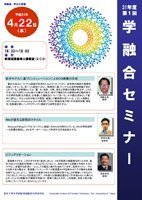AY2009 1st Gakuyugo Seminar
- Date&Time:
- Apr 22, 2009 16:30~18:00
- Venue:
- Large Lecture Room (2C0), New Frontier Science Bldg.

Generation of CG images by simulation based on particle models
Professor Tomoyuki Nishida
Recently, CG images are being used everywhere, and the importance of rendering the natural world is increasing. Realistic images of natural objects based on physical laws, rather than focusing on appearance, are required. There are various natural objects such as clouds, water, topography, atmosphere, and dust, but most of them are a collection of particles from a microscopic point of view. This paper describes a drawing method that takes into account the dynamic changes in the shape of materials composed of particles and optical effects (light scattering). Water and clouds change dynamically as fluids, and they are seen by the observer through the scattering and attenuation of light particles. We will introduce our research on interactive rendering of such phenomena by high-speed calculation of CFD (Computational Fluid Dynamics) and optical effects (scattered light) using GPU (Graphics Processing Unit).

Wiki changes the style of research
Associate Professor Masanori Arita
This presentation will explain the impact of wikis on academic research and show how to use wikis as a database.

visualization
Professor Koji Okamoto
High-speed cameras have come a long way in the past five years, easily capturing 7,500 frames per second with a resolution of 1 million pixels. They are now widely used not only to visualize various phenomena in fluids, but also as a quantitative measurement tool. By dispersing tracer particles in the fluid and using a high-speed pulsed laser in combination with a high-speed camera to process the images, it has become easy to measure the velocity distribution in the fluid at multiple points simultaneously (a measurement method called PIV). We can easily obtain information that 10 years ago would have required the use of 10,000 hot wire anemometers (not feasible at all). This has resulted in breakthroughs in fluid and thermal engineering.
*The contents of this page were developed based on a machine translation.

